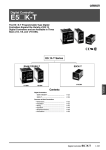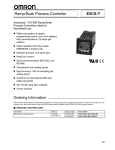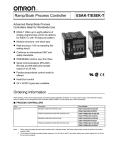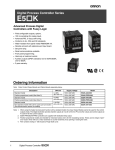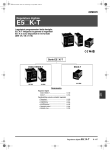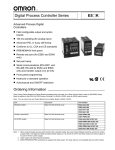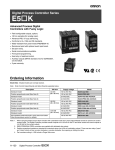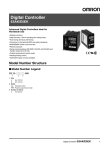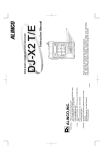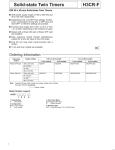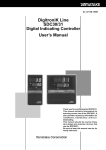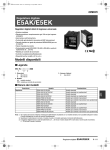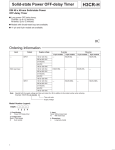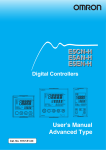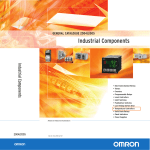Download E5AK-T, E5EK-T, E5CK-T
Transcript
Digital Controller E5jK-T The E5jK-T Programmable Type Digital Controllers Expand the Variety of E5jK Digital Controllers and are Available in Three Sizes (1/4, 1/8, and 1/16 DIN). RC This product was manufactured at OMRON Okayama. OMRON Okayama has obtained approvals from international certification bodies for its quality system and environmental management system. E5jK-T Series E5AK-T/E5EK-T 1/4 DIN E5CK-T 1/16 DIN 1/8 DIN Contents Digital Controllers E5AK-T/E5EK-T . . . . . . . . . . . . . . . . . . . . . 3 E5CK-T . . . . . . . . . . . . . . . . . . . . . . . . . . . . 9 Common to Both Controllers • Setup . . . . . . . . . . . . . . . . . . . . . . . . . . . . . • Dimensions . . . . . . . . . . . . . . . . . . . . . . . . . • Installation . . . . . . . . . . . . . . . . . . . . . . . . . . • Setup Mode Operation . . . . . . . . . . . . . . . . • General Specification . . . . . . . . . . . . . . . . . • Parameter Operations . . . . . . . . . . . . . . . . . • Error Display . . . . . . . . . . . . . . . . . . . . . . . . • Precautions . . . . . . . . . . . . . . . . . . . . . . . . 13 18 20 29 30 32 38 39 1 E5jK-T E5jK-T Compact and Easy-to-use Controllers Programming is as easy as following the steps below. Program can be set in pattern 0 according to the following procedure. 4. Set the target value to “50.” SP 100 Step 1 Step 2 5p0 Step 3 0 50 Target value Up key 50 0.20 0.40 0.20 Time: hours and minutes Step No. Target value 5. Press the Display Key to shift to the display for the time of step 0. Time (hours.minutes) 0 50 0.00 1 100 0.20 2 100 0.40 3 50 0.20 ti0 0 000 Time parameter for step 0. Step time (Default setting: 0.00) Pattern No. Display key 1. Press the Display Key to shift to the display for the number of steps. 5no 0 8 Parameter for the number of steps used 6. Press the Display Key again with the step time set at 0 minutes, and the target value parameter for step 1 will be displayed. Number of steps (Default setting: 8) Pattern No. 0 5p1 0 Display key 2. Press the Down Key and set the number of steps. 7. Press the Up Key to increment to “100.” 5no 0 4 Display key Four steps in this case 0 Down key 3. Press the Display Key to shift to the display for the target value of step 0. 0 5p0 0 Step 0 Parameter of the target value Target value (Default setting: 0) Display key 2 5p1 100 Up key In the same manner, set the time for step 1, target value for step 2, time for step 2, etc. When the target value and time settings are complete, press the Display Key. Digital Controller E5AK-T/E5EK-T Advanced Programmable Digital Controllers Ideal for Worldwide Use Offers up to eight patterns of simple programming control (16 steps per pattern). Modular structure, one-stock type High-accuracy: 100-ms sampling (for analog input) Conforms to international EMC and safety standards. IP66/NEMA4 (indoor use) front face Serial communications (RS-232C, RS-422 and RS-485) and transfer output (4 to 20 mA) RC Position-proportional control model Heat/Cool control 24VAC/DC types are also available. Ordering Information Description Base ase Unit U Note: Model Specification E5AK-TAA2 AC100-240 Standard model E5AK-TAA2-500 AC100-240 Standard model with terminal cover E5AK-TAA2 AC/DC24 Standard model E5AK-TAA2-500 AC/DC24 Standard model with terminal cover E5AK-TPRR2 AC100-240 Position-proportional model E5AK-TPRR2-500 AC100-240 Position-proportional model with terminal cover E5AK-TPRR2 AC/DC24 Position-proportional model E5AK-TPRR2-500 AC/DC24 Position-proportional model with terminal cover E5EK-TAA2 AC100-240 Standard model E5EK-TAA2-500 AC100-240 Standard model with terminal cover E5EK-TAA2 AC/DC24 Standard model E5EK-TAA2-500 AC/DC24 Standard model with terminal cover E5EK-TPRR2 AC100-240 Position-proportional model E5EK-TPRR2-500 AC100-240 Position-proportional model with terminal cover E5EK-TPRR2 AC/DC24 Position-proportional model E5EK-TPRR2-500 AC/DC24 Position-proportional model with terminal cover 1. When using the heater burnout alarm function with a standard model, the Linear Output Unit cannot be used for the control outputs (heat). 2. Be sure to specify the Current Transformer, Output Unit, and Option Unit when ordering. 3 E5AK-T/E5EK-T E5AK-T/E5EK-T Description Model Output Unit Note: Relay E53-S SSR E53-Q Pulse (NPN) 12 VDC at 40 mA max. E53-Q3 Pulse (NPN) 24 VDC at 20 mA max. E53-Q4 Pulse (PNP) 24 VDC at 20 mA max. E53-C3 Linear (4 to 20 mA) under a load of 600 Ω max. E53-C3D Linear (0 to 20 mA) under a load of 600 Ω max. E53-V34 Linear (0 to 10 V) under a load of 1 kΩ min. E53-V35 Linear (0 to 5 V) under a load of 1 kΩ min. The Digital Controller uses a dedicated, high-resolution Output Unit. The E53-C Current Output Unit for the E5jX cannot be used with the Digital Controller. Description Model Option Unit Note: Specification E53-R Specification E53-AKB Event input E53-AK01 Communication (RS-232C) E53-AK02 Communication (RS-422) E53-AK03 Communication (RS-485) E53-AKF Transfer output 1. The Option Unit can be used either by the E5AK or E5EK. 2. The E5AK allows a maximum of three Option Units to be mounted. Refer to page 13 for mounting combinations. The E5EK allows only one Option Unit to be mounted. Inspection Report The Digital Controller can be provided together with an inspection report. Refer to the following legend with the suffix “K” when ordering a model provided together with an inspection report. E5jK-TAA2-K, E5jK-TPRR2-K Accessories (Order Separately) Name Model Current Transformer Note: Hole diameter E54-CT1 5.8 dia. E54-CT3 12.0 dia. No CT is required unless the heater burnout alarm function is used. Name Model Terminal Cover Connectable models E53-COV0809 E5AK E53-COV08 E5EK Unit Label Model Y92S-L1 Ranges Platinum Resistance Thermometer Input (switch selectable) Range JPt100 Pt100 °C –199.9 to 650.0 –199.9 to 650.0 °F –199.9 to 999.9 –199.9 to 999.9 0 1 Setting Thermocouple Input (switch selectable) (see note) Range Setting Note: 4 K1 K2 J1 J2 T E L1 L2 U N R S B W PLII °C –200 to 1,300 0.0 to 500.0 –100 to 850 0.0 to 400.0 –199.9 to 400.0 0 to 600 –100 to 850 0.0 to 400.0 –199.9 to 400.0 –200 to 1,300 0 to 1,700 0 to 1,700 100 to 1,800 0 to 2,300 0 to 1,300 °F –300 to 2,300 0.0 to 900.0 –100 to 1,500 0.0 to 750.0 –199.9 to 700.0 0 to 1,100 –100 to 1,500 0.0 to 750.0 –199.9 to 700.0 –300 to 2,300 0 to 3,000 0 to 3,000 300 to 3,200 0 to 4,100 0 to 2,300 2 3 4 5 6 7 8 9 10 11 12 13 14 15 16 Setting number is factory-set to 2 (K1). E5AK-T/E5EK-T E5AK-T/E5EK-T Current/Voltage Input (switch selectable) Current input 4 to 20 mA Voltage input 0 to 20 mA 1 to 5 V 0 to 5 V Range One of following ranges depending on results of scaling –1999 to 9999 –199.9 to 999.9 –19.99 to 99.99 –1.999 to 9.999 Setting 17 18 19 20 0 to 10 V 21 Specifications Ratings Item 100- to 240-VAC type 24-VAC/VDC type Supply voltage 100 to 240 VAC, 50/60 Hz 24 VAC/VDC, 50/60 Hz Power consumption E5AK: 16 VA E5EK: 15 VA 12 VA, 8 W Operating voltage range 85% to 110% of rated supply voltage Sensor input Thermocouple: K, J, T, E, L, U, N, R, S, B, W, PLII Platinum resistance thermometer: JPt100, Pt100 Current input: 4 to 20 mA, 0 to 20 mA (Input impedance: 150 Ω) Voltage input: 1 to 5 V, 0 to 5 V, 0 to 10 V (Input impedance: 1 MΩ) Control output According to Output Unit (see Output Unit Ratings and Characteristics) Auxiliary output SPST-NO, 3 A at 250 VAC (resistive load) Control method ON/OFF or 2-PID control (with auto-tuning) Setting method Digital setting using front panel keys Indication method 7-segment digital display and LEDs Event input Contact input: No-contact input: Transfer output 4 to 20 mA, permissible load impedance: 600 Ω max., resolution: approx. 2,600 Current Transformer input Connect an exclusive Current Transformer (E54-CT1 or E54-CT3) Other functions Standard Manual output, heating/cooling control, SP limiter, loop burnout alarm, MV limiter, MV change rate limiter, input digital filter, input shift, run/reset, protect functions, scaling function ON: 1 kΩ max., OFF: 100 kΩ min. ON: residual voltage: 1.5 V max., OFF: leakage current: 0.1 mA max. 5 E5AK-T/E5EK-T E5AK-T/E5EK-T Characteristics Indication accuracy (see note) Thermocouple: (±0.3% of indication value or ±1°C, whichever greater) ±1 digit max. Platinum resistance thermometer: (±0.2% of indication value or ±0.8°C, whichever greater) ±1 digit max. Analog input: ±0.2% FS ±1 digit max. Hysteresis 0.01% to 99.99% FS (in units of 0.01% FS) Proportional band (P) 0.1% to 999.9% FS (in units of 0.1% FS) Integral (reset) time (I) 0 to 3,999 s (in units of 1 s) Derivative (rate) time (D) 0 to 3,999 s (in units of 1 s) Control period 1 to 99 s (in units of 1 s) Manual reset value 0.0% to 100.0% (in units of 0.1%) Alarm setting range –1,999 to 9,999 or –199.9 or 999.9 (decimal point position dependent on input type or result of scaling) Set time 0 to 99 hrs 59 min or 0 to 99 min 59 s Program capacity 8 patterns (E5AK) or 4 patterns (E5EK), 16 steps Programming method Time or ramp setting method Time accuracy ±0.2% (±500 ms) of the set value Sampling period Temperature input: 250 ms Analog input: 100 ms Insulation resistance 20 MΩ min. (at 500 VDC) Dielectric strength 2,000 VAC, 50/60 Hz for 1 min between terminals of different polarities Vibration resistance Malfunction: 10 to 55 Hz, 10 m/s2 (approx. 1G) for 10 min each in X, Y, and Z directions Destruction: 10 to 55 Hz, 20 m/s2 (approx. 2G) for 2 hrs each in X, Y, and Z directions Shock resistance Malfunction: 200 m/s2 min. (approx. 20G), 3 times each in 6 directions (100 m/s2 (approx. 10G) applied to the relay) Destruction: 300 m/s2 min. (approx. 30G), 3 times each in 6 directions Ambient temperature Operating: Storage: Ambient humidity Operating: 35% to 85% Enclosure ratings Front panel: NEMA4 for indoor use (equivalent to IP66) Rear case: IEC standard IP20 Terminals: IEC standard IP00 Memory protection Non-volatile memory (number of writings: 100,000 operations) Weight E5AK: approx. 450 g E5EK: approx. 320 g Mounting bracket: approx. 65 g EMC Emission Enclosure: Emission AC Mains: Immunity ESD: –10°C to 55°C (with no icing)/3-year warranty period: –10°C to 50°C –25°C to 65°C (with no icing) Immunity RF-interference: Immunity Conducted Disturbance: Immunity Burst: Approved standards Note: 6 EN55011 Group 1 class A EN55011 Group 1 class A EN61000-4-2: 4 kV contact discharge (level 2) 8 kV air discharge (level 3) ENV50140: 10 V/m (amplitude modulated, 80 MHz to 1 GHz) (level 3) 10 V/m (pulse modulated, 900 MHz) ENV50141: 3 V (47 to 68 MHz) 10 V (0.15 to 47 MHz, 68 to 80 MHz) (level 3) EN61000-4-4: 2 kV power-line (level 3) 2 kV I/O signal-line (level 4) UL1092, CSA22.2 No. 14, CSA C22.2 No. 142 Conforms to EN50081-2, EN50082-2, EN61010-1 (IEC1010-1) Conforms to VDE0106/part 100 (Finger Protection), when the separately-ordered terminal cover is mounted. The indication accuracy of the K1, T, and N thermocouples at a temperature of -100°C max. The indication accuracy of the U, L1, and L2 thermocouples at any temperature is ±2°C ±1 digit maximum. The indication accuracy of the B thermocouple at a temperature of 400°C max. is unrestricted. The indication accuracy of the R and S thermocouples at a temperature of 200°C max. is ±3°C ±1 digit maximum. The indication accuracy of the W thermocouple at any temperature is (±0.3% of the indicated value or ±2°C, whichever is greater) ±1 digit maximum. The indication accuracy of the PLII thermocouple at any temperature is (±0.3% of the indicated value or ±2°C, whichever is greater) ±1 digit maximum. E5AK-T/E5EK-T E5AK-T/E5EK-T Output Unit Ratings and Characteristics Model Specifications E53-R Relay output 5 A at 250 VAC (resistive load) E53-S SSR output 1 A at 75 to 250 VAC (resistive load) E53-Q E53-Q3 Voltage output NPN: 40 mA at 12 VDC E53-Q4 E53-C3 Linear current output Linear voltage output E53-V35 Note: NPN: 20 mA at 24 VDC (with short-circuit protection) PNP: 20 mA at 24 VDC (with short-circuit protection) 4 to 20 mA, permissible load impedance: 600 Ω max., resolution: approx. 2,600 0 to 20 mA, permissible load impedance: 600 Ω max., resolution: approx. 2,600 E53-C3D E53-V34 (with short-circuit protection) 0 to 10 VDC, permissible load impedance: 1 kΩ min., resolution: approx. 2,600 0 to 5 VDC, permissible load impedance: 1 kΩ min., resolution: approx. 2,600 An output relay (1 A at 250 VAC) is mounted on the position-proportional model. (When replacing, use the E53-R.) Option Unit Ratings and Characteristics Model E53-AKB Specifications Event input Contact input: ON: 1 kΩ max., OFF: 100 kΩ min. No-contact input: ON: residual voltage 1.5 V max., OFF: leakage current 0.1 mA max. E53-AK01 Communications Co u ca o s E53-AK02 RS-422 E53-AK03 E53-AKF Note: RS-232C Transmission a s ss o method: e od Half-duplex a du e S Synchronization h i ti method: th d Start-stop St t t synchronization h i ti (asynchronous ( h method) th d) Baud rate: 1.2/2.4/4.8/9.6/19.2 1 2/2 4/4 8/9 6/19 2 kbps RS-485 Transfer output 4 to 20 mA: Permissible load impedance: 600 Ω max. Resolution: approx. 2,600 Event input is used for switching the target value, run or stop command, or automatic and manual mode with an external signal input. Current Transformer Ratings Dielectric strength 1,000 VAC (for 1 min) Vibration resistance 50 Hz, 98 m/s2 (10G) Weight E54-CT1: approx. 11.5 g; E54-CT3: approx. 50 g Accessories (E54-CT3 only) Armature: 2; Plug: 2 Heater Burnout Alarm Max. heater current Single-phase 50 A VAC (see note 1) Heater current value display accuracy ±5% FS±1 digit max. Heater burnout alarm setting range 0.1 to 49.9 A (in units of 0.1 A) (see note 2) Min. detection ON time 190 ms (see note 3) Note: 1. Use the K2CU-FjjA-jGS (with gate input terminals) for the detection of three-phase heater burnout. 2. The heater burnout alarm is always OFF if the alarm is set to 0.0 A and always ON if the alarm is set to 50.0 A. 3. No heater burnout detection or heater current value measurement is possible if the control output (heat) is ON for less than 190 ms. 7 E5AK-T/E5EK-T E5AK-T/E5EK-T Nomenclature E5AK Pattern Number Display 1 Indicates the pattern number. Displays the process value or parameter code. Program Status Indicators Display 2 The top indicator indicates the rising step, the middle indicator indicates the constant step, and the bottom indicator indicates the falling step. Displays the present SP, manipulated variable, or parameter settings. Bar Graph Indicates the rate of pattern elapsing time at the rate of 20% (5 levels) per one segment. Operation Indicators • • • • • • • • • • OUT1 Lit when the pulse output function assigned to control output 1 turns ON. OUT2 Lit when the pulse output function assigned to control output 2 turns ON. Up Key/Down Key Press to increase or decrease the value on the No.2 display. SUB1 Lit when the output function assigned to auxiliary output 1 turns ON. SUB2 Lit when the output function assigned to auxiliary output 2 turns ON. Display Key MANU Lit when the manual operation mode. Press to shift the display to the next parameter. RST Lit when the operation is reset. RMT Lit during remote operation. RUN/RST Key Switches between RUN and RESET mode. AT Flashes during auto-tuning. HOLD Lit when the program is on hold. WAIT Lit when the program is waiting. E5EK Display 1 Pattern Number Display 2 Operation indicators Up Key/Down Key Display Key RUN/RST Key 8 Digital Controller E5CK-T Advanced, Compact Programmable Digital Controllers Ideal for Worldwide Use Offers up to four patterns of simple programming control (16 steps per pattern). IP66/NEMA4 (indoor use) front face. Modular structure, one-stock type. Heat/Cool control. Serial communications (RS-232C and RS-485). Temperature and analog inputs. High-accuracy: 100-ms sampling (for analog input). Conforms to international EMC and safety standards. 24 VAC/DC types are also available. Ordering Information Description Base Unit Note: Model Specification E5CK-TAA1 AC100-240 Standard model E5CK-TAA1-500 AC100-240 Standard model with terminal cover E5CK-TAA1 AC/DC24 Standard model E5CK-TAA1-500 AC/DC24 Standard model with terminal cover A single Output Unit and Option Unit can be mounted to each Base Unit. Description Output Unit Model Relay/Relay E53-Q4R4 Pulse (NPN)/Relay E53-Q4HR4 Pulse (PNP)/Relay E53-C4R4 Linear (4 to 20 mA)/Relay E53-C4DR4 Linear (0 to 20 mA)/Relay E53-V44R4 Linear (0 to 10 V)/Relay E53-Q4Q4 Pulse (NPN)/Pulse (NPN) E53-Q4HQ4H Pulse (PNP)/Pulse (PNP) Description Option Unit Specification E53-R4R4 Model Specification E53-CK01 RS-232C E53-CK03 RS-485 E53-CKB Event input: 1 point E53-CKF Transfer output (4 to 20 mA) Inspection Report The Digital Controller can be provided together with an inspection report. Refer to the following legend with the suffix “K” when ordering a model provided together with an inspection report. E5CK-TAA1-K Accessories (Order Separately) Name Terminal Cover Model E53-COV07 9 E5CK-T E5CK-T Temperature Ranges Platinum Resistance Thermometer Input (switch selectable) Range JPt100 Pt100 °C –199.9 to 650.0 –199.9 to 650.0 °F –199.9 to 999.9 –199.9 to 999.9 0 1 Resolution (°C/°F) (main setting and alarm) Thermocouple Input (switch selectable) (see note) Range K1 K2 J1 J2 T °C –200 to 1,300 0.0 to 500.0 –100 to 850 0.0 to 400.0 °F –300 to 2,300 0.0 to 900.0 –100 to 1,500 2 3 4 Resolution (°C/°F) (main setting and alarm) Note: E L1 L2 U N R S B W PLII –199.9 to 400.0 0 to 600 –100 to 850 0.0 to 400.0 –199.9 to 400.0 –200 to 1,300 0 to 1,700 0 to 1,700 100 to 1,800 0 to 2,300 0 to 1,300 0.0 to 750.0 –199.9 to 700.0 0 to 1,100 –100 to 1,500 0.0 to 750.0 –199.9 to 700.0 –300 to 2,300 0 to 3,000 0 to 3,000 300 to 3,200 0 to 4,100 0 to 2,300 5 6 7 8 9 10 11 12 13 14 15 16 Setting number is factory-set to 2 (K1). Current/Voltage Input (switch selectable) Current input 4 to 20 mA Voltage input 0 to 20 mA 1 to 5 V 0 to 5 V Range One of following ranges depending on results of scaling –1999 to 9999 –199.9 to 999.9 –19.99 to 99.99 –1.999 to 9.999 Resolution (°C/°F) (main setting and alarm) 17 18 19 20 0 to 10 V 21 Specifications Ratings Item 100- to 240-VAC type 24-VAC/VDC type Supply voltage 100 to 240 VAC, 50/60 Hz 24 VAC/VDC, 50/60 Hz Power consumption 15 VA 6 VA, 3.5 W Operating voltage range 85% to 110% of rated supply voltage Sensor input Thermocouple: K, J, T, E, L, U, N, R, S, B, W, PLII Platinum resistance thermometer: JPt100, Pt100 Current input: 4 to 20 mA, 0 to 20 mA Voltage input: 1 to 5 V, 0 to 5 V, 1 to 10 V Input impedance Current input: 150 Ω Voltage input: 1 MΩ min. Control output According to Output Unit (see Output Unit Ratings and Characteristics) Auxiliary output SPST-NO, 3 A at 250 VAC (resistive load) Control method ON/OFF or 2-PID control Setting method Digital setting using front panel keys Indication method 7-segment digital display and LEDs Other functions Standard Manual output, heating/cooling control, SP limiter, loop burnout alarm, MV limiter, MV change rate limiter, input digital filter, input shift, run/reset, protect functions, scaling function 10 E5CK-T E5CK-T Characteristics Indication accuracy (see note 1) Thermocouple: (±0.3% of indication value or ±1°C, whichever greater) ±1 digit max. Platinum resistance thermometer: (±0.2% of indication value or ±0.8°C, whichever greater) ±1 digit max. Analog input: ±0.2% FS ±1 digit max. Hysteresis 0.01% to 99.99% FS (in units of 0.01% FS) Proportional band (P) 0.1% to 999.9% FS (in units of 0.1% FS) Integral (reset) time (I) 0 to 3,999 s (in units of 1 s) Derivative (rate) time (D) 0 to 3,999 s (in units of 1 s) Control period 1 to 99 s (in units of 1 s) Manual reset value 0.0% to 100.0% (in units of 0.1%) Alarm setting range –1,999 to 9,999 or –199.9 or 999.9 (decimal point position dependent on input type) Program capacity 4 patterns, 16 steps (possible to use up to 4 patterns with the communications function.) Programming method Time or ramp setting method Time accuracy ±0.2% (±500 ms) of the set value Sampling period (see note 2) Temperature input: 250 ms Analog input: 100 ms Insulation resistance 20 MΩ min. (at 500 VDC) Dielectric strength 2,000 VAC, 50/60 Hz for 1 min between terminals of different polarities Vibration resistance Malfunction: 10 to 55 Hz, 10 m/s2 (approx. 1G) for 10 min each in X, Y, and Z directions Destruction: 10 to 55 Hz, 20 m/s2 (approx. 2G) for 2 hrs each in X, Y, and Z directions Shock resistance Malfunction: 200 m/s2 min. (approx. 20G), 3 times each in 6 directions (100 m/s2 (approx. 10G) applied to the relay) Destruction: 300 m/s2 min. (30G), 3 times each in 6 directions Ambient temperature Operating: Storage: Ambient humidity Operating: 35% to 85% Enclosure ratings Front panel: NEMA4 for indoor use (equivalent to IP66) Rear case: IEC standard IP20 Terminals: IEC standard IP00 Memory protection Non-volatile memory (number of writings: 100,000 operations) Weight Approx. 170 g; Adapter: approx. 10 g EMC Emission Enclosure: Emission AC Mains: Immunity ESD: –10°C to 55°C (with no icing)/3-year warranty period: –10°C to 50°C –25°C to 65°C (with no icing) Immunity RF-interference: Immunity Conducted Disturbance: Immunity Burst: Approved standards Note: EN55011 Group 1 class A EN55011 Group 1 class A EN61000-4-2:4kV contact discharge (level 2) 8kV air discharge (level 3) ENV50140: 10V/m (amplitude modulated, 80 MHz to 1 GHz) (level 3) 10 V/m (pulse modulated, 900 MHz) ENV50141: 3 V (47 to 68 MHz) 10 V (0.15 to 47 MHz, 68 to 80 MHz) (level 3) EN61000-4-4:2kV power-line (level 3) 2kV I/O signal-line (level 4) UL1092, CSA22.2 No. 14, CSA C22.2 No. 142 Conforms to EN50081-2, EN50082-2, EN61010-1 (IEC1010-1) Conforms to VDE0106/ part 100 (Finger Protection), when the separately-ordered terminal cover is mounted. The indication accuracy of the K1, T, and N thermocouples at a temperature of -100°C max. The indication accuracy of the U, L1, and L2 thermocouples at any temperature is ±2°C ±1 digit maximum. The indication accuracy of the B thermocouple at a temperature of 400°C max. is unrestricted. The indication accuracy of the R and S thermocouples at a temperature of 200°C max. is ±3°C ±1 digit maximum. The indication accuracy of the W thermocouple at any temperature is (±0.3% of the indicated value or ±3°C, whichever is greater) ±1 digit maximum. The indication accuracy of the PLII thermocouple at any temperature is (±0.3% or ±2°C, whichever is greater) ±1 digit maximum. 11 E5CK-T E5CK-T Output Unit Ratings and Characteristics Model Control output 1/Control output 2 E53-R4R4 Relay / Relay E53-Q4R4 Voltage (NPN) / Relay E53-Q4HR4 Voltage (PNP) / Relay E53-C4R4 4 to 20 mA / Relay E53-C4DR4 0 to 20 mA / Relay E53-V44R4 0 to 10 mA / Relay E53-Q4Q4 Voltage (NPN) / Voltage (NPN) E53-Q4HQ4H Voltage (PNP) / Voltage (PNP) Output Type Specifications Relay Voltage (NPN) Voltage (PNP) 250 VAC. 3 A 12 VDC, 20 mA (with short-circuit protection) 12 VDC, 20 mA (with short-circuit protection) 0 to 10 V 0 to 10 VDC, Permissible load impedance: 1 kΩ min., Resolution: Approx. 2600 4 to 20 mA 4 to 20 mA, Permissible load impedance: 500 Ω max., Resolution: Approx. 2600 Option Unit Ratings and Characteristics Model E53-CKB Specifications Event input Contact input: ON: 1 kΩ max., OFF: 100 kΩ min. No-contact input: ON: residual voltage 1.5 V max., OFF: leakage current 0.1 mA max. E53-CK01 Communications E53-CK03 E53-CKF Note: RS-232C RS-485 Transfer output Transmission method: Half-duplex Synchronization method: Start-stop synchronization (asynchronous method) Baud rate: 1.2/2.4/4.8/9.6/19.2 kbps 4 to 20 mA DC: Permissible load impedance: 600 Ω max. Resolution: approx. 2,600 Event input is used for switching the target value, run or stop command, or automatic and manual mode with an external signal input. Nomenclature Display 1 Display 2 Operation Indicators Up Key/Down Key Display Key RUN/RST Key 12 E5jK-T E5jK-T Setup Note: Always turn OFF the power supply to the Digital Controller before changing any switch settings. Settings (E5AK/E5EK) On a standard model, set up the Output Units for control outputs 1 and 2 before mounting the Controller. On a position-proportional model, the Relay Output Unit is already set. Therefore, this setup operation is unnecessary. (Do not replace with other Output Units.) When setting up the Output Units, draw out the internal mechanism from the housing and insert the Output Units into the sockets for control outputs 1 and 2. 2. Insert the Output Unit for control output 1 into the socket “OUT1” and the Output Unit for control output 2 into the socket “OUT2.” 3. Fasten the Output Units with the bracket (accessory). Setting Up the Option Unit • • E5AK Draw-out When drawing out the internal mechanism from the housing, prepare a Phillips screwdriver matched to the size of the screw on the lower part of the front panel. 1. Press down on the hook on the top of the front panel, and turn the Phillips screwdriver to the left to loosen the screw on the lower part of the front panel. Before Setup Check the type of the Option Unit you are about to set up. Procedure 1. Remove the power board and option boards in the order shown in the following diagram. Hook 2. Draw out the internal mechanism towards you holding both sides of the front panel. Setting Up the Output Unit • Before Setup Check the type of the Output Unit you are about to set up. • 2. Insert the Option Units into the sockets for options 1 to 3. The following diagram shows the relationship between the Option Units and mounting positions. Procedure 1. Check the positions of the sockets you are about to insert the Output Units into as shown in the following diagram. OUT1 OUT2 Bracket 3. Mount the Option Boards and the power board in the order shown. 13 E5jK-T E5jK-T Mounting 1. Insert the E5AK-T Controller into the mounting hole in the panel. 2. Fit the mounting bracket (accessory) into the fixing slots on the top and bottom of the rear case. Setting Up the Terminal Cover Fasten the Terminal Covers (E53-COV0809) to protect terminals. E5AK-VV2-500 Controller is provided with Terminal Covers. Use E53-COV09 for terminals 1 to 10, and E53-COV08 for terminals 11 to 33. Fasten the Terminal Covers as follows by using the snap pins. E5AK-T E53-COV0809 3. Tighten the mounting bracket screws alternately a little at a time until the ratchet starts to slide. 14 E5jK-T E5jK-T 2. Remove the power board in the direction of the arrow in the figure below. The power board is connected to the control board by a connector at the center of the board. E5EK Draw-out When drawing out the internal mechanism from the housing, prepare a Phillips screwdriver matched to the size of the screw on the lower part of the front panel. 1. Press down on the hook on the top of the front panel, and turn the Phillips screwdriver to the left to loosen the screw on the lower part of the front panel. Control board Power board 2. Draw out the internal mechanism towards you holding both sides of the front panel. 3. Insert the Output Unit for control output 1 into the socket “OUT1” and the Output Unit for control output 2 into the socket “OUT2.” 4. Fasten the Output Units with the bracket (accessory). 5. Mount the power board at its original position. Setting Up the Output Unit • Before Setup Check the type of the Option Unit you are about to set up. • Procedure Setting Up the Option Unit 1. Check the positions of the sockets you are about to insert the Output Units into as shown in the following diagram. Check the type of the Option Unit you are about to set up. • • Before Setup Procedure 1. Remove the power board and Option Boards in the order shown in the following diagram. OUT1 OUT2 Bracket 15 E5jK-T E5jK-T 2. Insert the Option Unit into the socket for option 1. The following diagram shows the relationship between Option Unit and mounting position. 3. Tighten the mounting bracket screws alternately a little at a time until the ratchet starts to slide. Option 1 E53-AKB: Event inputs 1/2 E53-AK01: RS-232C E53-AK02: RS-422 E53-AK03: RS-485 E53-AKF: Transfer output 3. Mount the Option Board and the power board in the order shown. Mounting 1. Insert the E5EK-T Controller into the mounting hole in the panel. 2. Fit the mounting bracket (accessory) into the fixing slots on the top and bottom of the rear case. Setting Up the Terminal Cover Fasten the Terminal Covers (E53-COV0809) to protect terminals. E5AK-VV2-500 Controller is provided with Terminal Covers. Use E53-COV09 for terminals 1 to 10, and E53-COV08 for terminals 11 to 33. Fasten the Terminal Covers as follows by using the snap pins. E5AK-T E53-COV08 To remove the Terminal Covers, pull the edges of the snap pins. 16 E5jK-T E5jK-T E5CK Draw-out Draw out the internal mechanism from the housing. 1. Press in both of the hooks on the left and right sides of the front panel to unlock the internal mechanism from the housing. 2. Draw out the internal mechanism towards you holding both sides of the front panel. Setting Up the Output Unit • Procedure 1. Two rectangular holes for slotting are provided on the power board (on right side of Controller). Fit the two protrusions on the Output Unit into these two holes. 2. With the Output Unit fitted into the power board, fit the Output Unit into the connector on the control board (on left side of Controller). 2. With the power board connected, fit the board vertically into the connector on the control board (on left side of Controller). Mounting 1. Insert the E5EK-T Controller into the mounting hole in the panel. 2. Push the adapter along the Controller body from the terminals up to the panel, and fasten temporarily. 3. Tighten the two fixing screws on the adapter. When tightening screws, tighten the two screws alternately keeping the torque to approximately 0.29 to 0.39 N S m, or 3 to 4 kgf S cm. Adapter Panel Waterproof packing Setting the Input Type Jumper Set the jumper to one of temperature input, voltage input or current input matched to the type of sensor connected to the input terminal. Setting Up the Option Unit • I : Current input V : Voltage input Procedure 1. Place the Controller with its bottom facing up, and fit the board horizontally into the connector on the power board (on right side of Controller). TC/PT : Temperature input The input type jumper is factory-set to “TC/PT (temperature input).” When you disconnect or insert the input type jumper, do not hold it directly by its pins. When you have finished setting the input type jumper, insert the internal mechanism back into the housing. To do this, push in the internal mechanism until you hear the hooks on the front panel snap into place. 17 E5jK-T E5jK-T Dimensions Note: All units are in millimeters unless otherwise indicated. E5AK Panel Cutouts 96 x 96 91 x 91 110 min. Note: 120 min. 1. Recommended panel thickness is 1 to 8 mm. 2. Maintain the specified vertical and horizontal mounting space between each Unit. Units must not be closely mounted vertically or horizontally. Panel Cutouts E5EK 60 min. 120 min. Note: 1. Recommended panel thickness is 1 to 8 mm. 2. Maintain the specified vertical and horizontal mounting space between each Unit. Units must not be closely mounted vertically or horizontally. E5CK Panel Cutouts 53 x 53 44.8 x 44.8 65 min. Note: 18 60 min. 1. Recommended panel thickness is 1 to 5 mm. 2. Maintain the specified vertical and horizontal mounting space between each Unit. Units must not be closely mounted vertically or horizontally. E5jK-T E5jK-T Accessories (Order Separately) Terminal Cover E53-COV0809 (E5AK) E53-COV08 (E5EK) (With rivet) (With rivet) E53-COV07 (With rivet) Current Transformer E54-CT1 E54-CT3 2.36 dia. 5.8 dia. 12 dia. 40x40 Two, M3 (depth: 4) 19 E5jK-T E5jK-T Rubber Seal Installation Wiring Terminals Terminal Arrangement E5AK-T E5EK-T 100-240 VAC 24 VDC/AC 100-240 VAC 24 VDC/AC SOURCE SOURCE TRSF: EV1/2: PTMR: TRSF: Transfer output EV1 to 4: Event input PTMR: Potentiometer E5CK-T OUT1 100-240 VAC 24 VDC/AC SOURCE 5 11 12 10 OUT2 4 9 3 8 SUB1 7 2 1 13 EV1 RS232C RS485 TRSF 20 14 IN 6 TRSF: Transfer output EV1: Event input Transfer output Event input Potentiometer E5jK-T E5jK-T Precautions when Wiring Use ducts to separate input leads and power lines in order to protect the Controller and its lines from external noise. Solderless terminals are recommended when wiring the Controller. Tighten the terminal screws using a torque no greater than 0.78 N S m, or 8 kgf S cm max. Take care not to tighten the terminal screws too tightly. Power Blocks The E5AK/E5EK has independent power supplies for each of the terminal blocks shown below. E5EK E5AK A B 10 9 8 7 6 5 4 3 2 1 B E C A C 30 31 32 29 28 27 26 25 24 23 22 21 33 F 20 19 18 17 16 15 14 13 12 11 10 21 22 9 8 7 6 5 4 3 2 1 23 B E D B/C F C 20 19 18 17 16 15 14 13 12 11 E5CK The E5CK has independent power supplies for each of the terminal blocks shown below. However, note that the power supplies for blocks C (exclude relay output) and D are shared for the following Option Unit. • Option Unit: E53-CKB or E53-CKF A D C 5 11 12 10 9 4 8 3 C 7 2 1 13 14 6 D B E5AK Wiring In the following wiring diagrams, the left side of the terminal numbers indicate the inside of the Controller. Power Supply Input 100 to 240 VAC or 24 VAC/DC to terminal numbers 9 and 10 according to the specifications. Sensor Input Connect the sensor input to terminal numbers 11 to 14 and 33 as follows according to the input type. 21 E5jK-T E5jK-T Control Output Terminal numbers 7 and 8 are for control output 1 (OUT1), and terminal numbers 5 and 6 are for control output 2 (OUT2). The following diagrams show the available Output Units and their internal equalizing circuits. With E53-Vjj Output Units, approx. 2 V is output for one second after the power is interrupted. With E5AK-TPRR2 Controllers, the relay output (1 A at 250 VAC) is fixed. When replacing the Output Unit, use the E53-R. The following diagrams show the relationship between terminals and open/close relay settings. 8 6 7 Open 5 Close Auxiliary Output Terminal numbers 3 and 4 are for auxiliary output 1 (SUB1) and terminal numbers 1 and 2 are for auxiliary output 2 (SUB2). The following diagrams show the internal equalizing circuits for the auxiliary outputs: 10 9 8 7 6 5 4 3 2 1 30 31 32 29 28 27 26 25 24 23 22 21 33 20 19 18 17 16 15 14 13 12 11 Output specifications are as follows: SPST-NO, 3 A at 250 VAC 22 4 3 Auxiliary output 1 2 1 Auxiliary output 2 E5jK-T E5jK-T CT Input/Potentiometer When using the HBA function on the E5AK-AA2 Controller, connect CT input (CT) to terminal numbers 15 to 17. When monitoring the valve opening on the E5AK-PRR2 Controller, connect the potentiometer (PTMR) to terminal numbers 15 to 17. Connect each of these inputs as follows: 30 31 32 29 28 27 26 25 24 23 22 21 33 10 9 8 7 6 5 4 3 2 1 20 19 18 17 16 15 14 13 12 11 17 17 CT 16 16 15 15 CT input O W C Potentiometer Event Input Connect event inputs 1 and 2 (EV1/2) to terminal numbers 18 to 20, and event events 3 and 4 (EV3/4) to terminal numbers 24 to 26. However, note that terminal numbers 18 to 20 cannot be used on Controllers with a communications function. Connect the event inputs as follows: 30 31 32 29 28 27 26 25 24 23 22 21 33 10 9 8 7 6 5 4 3 2 1 20 19 18 17 16 15 14 13 12 11 EV1 20 EV2 19 + + EV3 26 EV4 25 + + COM 18 – COM 24 – Event input 3 and 4 Event input 1 and 2 Terminals 18 and 24 (COM) are connected internally. Use event inputs under the following conditions: Contact input ON: 1 kΩ max. OFF: 100 kΩ min. No-contact input ON: Residual voltage 1.5 V max., OFF: Leakage current 0.1 mA max. Polarities during no-contact input are as follows: EV1 20 EV2 19 + + COM 18 – Event input 1 and 2 EV3 26 EV4 25 + + COM 24 – Event input 3 and 4 23 E5jK-T E5jK-T Transfer Output Connect transfer output (TRSF) to terminal numbers 29 and 30. The internal equalizing circuit for transfer output is as follows: 30 + 4 to 20mA L 29 – Transfer output specifications are as follows: 4 to 20 mA DC, Permissible load impedance: 600 Ω max., Resolution: Approx. 2,600 Communications Terminal numbers 18 to 20, 31 and 32 can be used only on Controllers with Communications Units (E53-AK01/02/03). For details on wiring, refer to Chapter 6, Using the Communications Function in the E5AK-T/E5EK-T/E5CK-T User’s Manual (H88/H89/H90). E5EK Wiring In the following wiring diagrams, the left side of the terminal numbers indicate the inside of the Controller. Power Supply Input 100 to 240 VAC or 24 VAC/DC to terminal numbers 9 and 10 according to the specifications. Sensor Input Connect the sensor input to terminal numbers 11 to 14 and 23 as follows according to the input type. 24 E5jK-T E5jK-T Control Output Terminal numbers 7 and 8 are for control output 1 (OUT1), and terminal numbers 5 and 6 are for control output 2 (OUT2). The following diagrams show the available Output Units and their internal equalizing circuits. With E53-Vjj Output Units, approx. 2 V is output for one second after the power is interrupted. With E5EK-TPRR2 Controllers, the relay output (1 A at 250 VAC) is fixed. When replacing the Output Unit, use the E53-R. The following diagrams show the relationship between terminals and open/close relay settings. 8 6 7 Open 5 Close Auxiliary Output Terminal numbers 3 and 4 are for auxiliary output 1 (SUB1) and terminal numbers 1 and 2 are for auxiliary output 2 (SUB2). The following diagrams show the internal equalizing circuits for the auxiliary outputs: 10 21 22 9 8 7 6 5 4 3 2 1 23 20 19 18 17 16 15 14 13 12 11 4 3 Auxiliary output 1 2 1 Auxiliary output 2 Output specifications are as follows: SPST-NO, 3A at 250 VAC 25 E5jK-T E5jK-T CT Input/Potentiometer When using the HBA function on the E5EK-AA2 Controller, connect CT input (CT) to terminal numbers 15 to 17. When monitoring the valve opening on the E5EK-TPRR2 Controller, connect the potentiometer (PTMR) to terminal numbers 15 to 17. Connect each of these inputs as follows: 10 21 22 9 8 7 6 5 4 3 2 1 23 20 19 18 17 16 15 14 13 12 11 17 17 16 16 15 15 CT input O W C Potentiometer For details on CT inputs, refer to Appendix, About Current Transformer in the E5AK-T/E5EK-T/E5CK-T User’s Manual (H88/H89/H90). For details on the potentiometer, refer to the Instruction Manual for the valve connected to the Controller. The variable resistance range is 100 Ω to 2.5 kΩ. Event Input Connect event inputs 1 and 2 (EV1/2) to terminal numbers 18 to 20. However, note that terminal numbers 18 to 20 cannot be used on Controllers with a communications function. Connect the event inputs as follows: 20 19 18 17 16 15 14 13 12 11 10 21 22 9 8 7 6 5 4 3 2 1 23 EV1 20 EV2 19 + + COM 18 – Event input 1 and 2 Use event inputs under the following conditions: Contact input ON: 1 kΩ max., OFF: 100 kΩ min. No-contact input ON: Residual voltage 1.5 V max., OFF: Leakage current 0.1 mA max. Polarities during no-contact input are as follows: EV1 20 EV2 19 + + COM 18 – Event input 1 and 2 Transfer Output Connect transfer output (TRSF) to terminal numbers 21 and 22. The internal equalizing circuit for transfer output is as follows: 21 + 4 to 20mA L 22 26 – E5jK-T E5jK-T Transfer output specifications are as follows:4 to 20 mA DC, Permissible load impedance: 600 Ω max., Resolution: Approx. 2,600 Communications Terminal numbers 18 to 22 can be used only on Controllers with Communications Units (E53-AK01/02/03). For details on wiring, refer to Chapter 6, Using the Communications Function in the E5AK-T/E5EK-T/E5CK-T User’s Manual (H88/H89/H90). E5CK Wiring Power Supply Input 100 to 240 VAC or 24 VAC/DC to terminal numbers 4 and 5 according to the specification. 5 11 12 10 4 9 3 8 2 7 1 13 14 6 Sensor Input Connect the input to terminal numbers 6 to 8 as follows according to the input type. 5 11 12 10 4 9 3 8 2 7 1 13 14 8 8 8 - 8 - - 7 7 7 7 V 6 6 + mA 6 + Thermocouple Platinum resistance thermometer 6 Voltage input TC ⋅ PT 6 + Current input V I Match the inputs with the internal jumper settings for each input type. For thermocouple or platinum resistance thermometer inputs, set the inputs to a common position (TC/PT) as the temperature input. Control Output Terminal numbers 11 and 12 are for control output 1 (OUT1). The five output types and internal equalizing circuits are available according to the Output Unit. 5 11 12 4 10 +v 11 12 GND 12 8 2 7 13 14 6 + +v 11 GND 12 NPN E53-R4R4 E53-Q4R4 E53-Q4Q4 + 11 12 - PNP mA L V L Relay + 11 L 9 3 1 + 11 - 0 to 10 V E53-Q4HR4 E53-Q4HQ4H L 12 - 4 to 20mA E53-V44R4 E53-C4R4 E53-C4DR4 Terminal numbers 9 and 10 are for control output 2 (OUT2). The three output types and internal equalizing circuits are available according to the Output Unit. + 10 +V 10 9 GND 9 + +V 10 GND 9 L - Relay NPN E53-R4R4 /E53-V44R4 E53-Q4R4 /E53-C4R4 E53-Q4HR4/E53-C4DR4 E53-Q4Q4 L - PNP E53-Q4HQ4H 27 E5jK-T E5jK-T Auxiliary Output 1 Terminal numbers 2 and 3 are for auxiliary output 1 (SUB1). The internal equalizing circuit for auxiliary output 1 is as follows: 5 11 12 10 4 9 3 8 2 7 13 1 14 3 2 6 Relay specifications are as follows: SPST-NO, 250 VAC, 1 A Option Terminal numbers 1, 13, and 14 are valid only when the Option Unit is set in the Controller. The following four connections are possible depending on the model of the Option Unit. 5 11 12 10 13 9 4 3 8 2 7 1 13 14 6 14 1 SD RD SG + A 13 13 13 14 14 14 1 1 1 4 to 20mA B RS-232C RS-485 Event input E53-CK01 E53-CK03 E53-CKB – Transfer output E53-CKF Use event inputs under the following conditions: Contact input ON: 1 kΩ max., OFF: 100 kΩ min. No-contact input ON: residual voltage 1.5 V max., OFF: leakage current 0.1 mA max. The polarity for no-contact input is as follows: 13 + 14 – 1 Transfer output specifications are as follows: 4 to 20 mA DC, load: 500 Ω max., resolution approx. 2,600 28 E5jK-T E5jK-T To previous column After Turning Power ON From previous column Determine the I/O specifications of the Digital Controller in setup mode. Control output 1 assignment (Not displayed by the E5jK-TPRR2) Setup Mode Control output 2 assignment (Not displayed by the E5jK-TPRR2) Power ON Process value Output assignment Auxiliary output 1 assignment 1 s min. Auxiliary output 2 assignment (Not displayed by the E5CK) Alarm 1 type prgn Alarm 1 open in alarm Alarm 1, 2, or 3 is not set. Alarm 2 type Alarm type Alarm 2 open in alarm Alarm 3 type 1 s min. Input type Temperature input Alarm 3 open in alarm Current/Voltage input Direct/Reverse operation Scaling upper limit °C/°F selection Scaling lower limit Note: Parameter Initialize Parameter initialization sets all parameters to default values except for the input type, scaling upper limit, scaling lower limit, decimal point, and °C/°F selection parameters. Decimal point Parameter initialize From next column To next column 29 E5jK-T E5jK-T Specifications Standard Models Input Type Assignment Destination Set the code according to the following table. Default is “2: K1 thermocouple.” Platinum Resistance Thermometer Set value 0 Input type JPt100 –199.9 to 650.0 (°C) /–199.9 to 999.9 (°F) 1 Pt100 –199.9 to 650.0 (°C) /–199.9 to 999.9 (°F) 2 K1 –200 to 1,300 (°C) /–300 to 2,300 (°F) 3 K2 0.0 to 500.0 (°C) /0.0 to 900.0 (°F) 4 J1 –100 to 850 (°C) /–100 to 1,500 (°F) 5 J2 0.0 to 400.0 (°C) /0.0 to 750.0 (°F) 6 T –199.9 to 400.0 (°C) /–199.9 to 700.0 (°F) 7 E 0 to 600 (°C) /0 to 1,100 (°F) 8 L1 –100 to 850 (°C) /–100 to 1,500 (°F) 9 L2 0.0 to 400.0 (°C) /0.0 to 750.0 (°F) 10 U –199.9 to 400.0 (°C) /–199.9 to 700.0 (°F) 11 N –200 to 1,300 (°C) /–300 to 2,300 (°F) 12 R 0 to 1,700 (°C) /0 to 3,000 (°F) 13 S 0 to 1,700 (°C) /0 to 3,000 (°F) 14 B 100 to 1,800 (°C) /300 to 3,200 (°F) 15 W 0 to 2,300 (°C) /0 to 4,100 (°F) 16 PLII 0 to 1,300 (°C) /0 to 2,300 (°F) 17 4 to 20 mA 18 0 to 20 mA 19 1 to 5 V 20 0 to 5 V 21 0 to 10 V Platinum resistance th t thermometer Thermocouple Auxiliary Output 1 2 1 2 Control output (heat) (see note 1) Yes Yes No No Control output (cool) (see note 1) Yes Yes No No Alarm 1 Alarm 2 Yes Yes Yes Yes Yes Yes Yes Yes Alarm 3 HBA (see notes 1, 2) Yes Yes Yes Yes Yes Yes Yes Yes LBA (see note 1) Time signal 1 Time signal 2 Yes Yes Yes Yes Yes Yes Yes Yes Yes Yes Yes Yes Program end Stage output (see note 1) Yes Yes Yes Yes Yes Yes Yes Yes Error 1 : Input error Error 2 : A/D convertor error No No Yes Yes No No Yes Yes Output Function Note: 1. Assignment is not possible with the control valve control type. 2. Heater burnout alarm is not available for the E5CK. Position-proportional Models Position-proportional-type Controllers support nine output functions. These are assigned to auxiliary outputs 1 and 2. Restrictions on assignment destinations are placed on some of the outputs. The following table shows where outputs may be assigned to. Assignment Destination Control Output Auxiliary Output 1 2 1 2 Alarm 1 Alarm 2 No No No No Yes Yes Yes Yes Alarm 3 Time signal 1 Time signal 2 No No No No No No Yes Yes Yes Yes Yes Yes Current input Stage output Program end output No No No No Yes Yes Yes Yes Voltage input Error 1 : Input error Error 2 : A/D converter error No No Yes Yes No No Yes Yes Output Function Output Assignments Thirteen output functions are available. Allocate these functions to the control outputs 1 and 2 and auxiliary outputs 1 and 2. There are some limitations on some output function allocations. Output function types and allocation limitations are as described in the following. Identical output functions cannot be allocated doubly to the control output 1 or 2 and auxiliary output 1 or 2. 30 Control Output With control output (cool), the conditions for switching from standard control to heating and cooling control are reached when the output function is assigned at the cooling side during heating and cooling control. In other words, heating and cooling control is carried out when control output (cool) is assigned, and standard control is carried out when output is not assigned. E5jK-T E5jK-T LBA The LBA (loop break alarm) function is available when it is assigned as an output. The LBA function is not available when a memory or A/D converter error results. LBA is a function for determining that an error has occurred somewhere on the control loop and outputting an alarm when the process value does not change with the manipulated variable at a maximum or minimum state. Accordingly, the LBA function can be used as a means for detecting a malfunctioning control loop. Alarm Mode Selectors Alarm outputs are available if they are allocated as outputs. Factory setting is “2: Upper-limit alarm (deviation).” Switch setting 1 Alarm operation Alarm output When X is positive Upper- and lower-limit alarm (deviation) X ON OFF 2 Upper-limit alarm (deviation) X When X is negative Always ON SP X ON OFF SP 3 Lower-limit alarm (deviation) X ON X ON OFF SP X ON OFF OFF SP 4 Upper- and lower-limit range alarm (deviation) X ON OFF 5 6 Upper- and lower-limit alarm with standby sequence (deviation) Upper-limit alarm with standby sequence (deviation) SP X Always OFF X Always OFF SP X ON OFF SP X ON ON OFF OFF SP 7 Lower-limit alarm with standby sequence (deviation) X ON Absolute-value upper-limit alarm OFF OFF 0 Absolute-value lower-limit alarm 0 X ON OFF 0 Absolute-value upper-limit alarm with standby sequence X ON X ON OFF 10 SP X ON OFF 9 X OFF X ON SP ON SP 8 X 0 X ON OFF OFF 0 11 Absolute-value lower-limit alarm with standby sequence 0 X ON ON OFF OFF 0 Deviation Alarm If the alarm mode selector is set to a number between 1 to 7, alarm values are set to the width deviated from the set point as shown in the following illustration. 0 Absolute Alarm If the alarm mode selector is set to 8 or 9, alarm values are set to the absolute value based on 0°C/°F as shown in the following illustration. Alarm value Alarm value 10°C/°F 110°C/°F Set point (SP) 100°C/°F X 110°C/°F 0°C/°F 110°C/°F 31 E5jK-T E5jK-T Close in Alarm/Open in Alarm When the Controller is set to “close in alarm,” the status of the alarm output function is output as it is. When set to “open in alarm,” the status of the alarm output function is output inverted. Condition Alarm Output Output LED C ose in Close alarm l ON ON Lit OFF OFF Not lit O e in Open alarm l ON OFF Lit OFF ON Not lit Alarm type and close in alarm (normally open)/open in alarm (normally close) can be set independently from each alarm. Close in alarm/Open in alarm is set in the “alarm 1 to 3 open in alarm” parameters (setup mode). Factory setting is “close in alarm” [ no ]. Parameter Operations Parameter Operation List Switching to modes other than manual or protect mode is carried out using the mode selection in the menu display. The figure below shows all parameters in the order that they are displayed. Some parameters are not displayed depending on the protect mode setting and conditions of use. Power ON 1 second min. 1 second min. Level 0 mode Manual mode 1 second min. Program mode 1 second min. 1 second min. Level 1 mode 1 second min. 1 second min. 1 second min. Level 2 mode Protect mode 1 second min. Setup mode 1 second min. 1 second min. Expansion mode 1 second min. Option mode 1 second min. Calibration mode Parameters and Menus Note: For more details on the functions of each part and display contents, refer to the E5AK-T/E5EK-T/E5CK-T User’s Manual (H88/H89/H90). Protect Mode The protect function is for preventing unwanted modification of parameters and switching between run and reset operation or auto and manual operation. Manual Mode In this mode, the Controller can be switched to manual operation. The manipulated variable can be manipulated manually only in this mode. 32 E5jK-T E5jK-T Level 0 Mode Set the Controller to this mode during normal operation. In this mode, you can change the set point and pattern during operation, and execute step operation (e.g. advance). You can only monitor (not change) the process value, step No., standby time, pattern elapsing time, pattern execution count, and manipulated variable. Program Mode This is the programming mode. In this mode, you can set the number of steps used in each pattern, pattern execution count, alarm values, set points for each step, step time, and time signals for two steps. Level 1 Mode This is the main mode for adjusting control. In this mode, you can execute AT (auto-tuning), and set up the control period, PID parameters and heater burnout alarm (HDA) conditions. Level 2 Mode This is the auxiliary mode for adjusting control. In this mode, you can set the parameters for limiting the manipulated variable, switch between the remote and local modes, and set the loop break alarm (LBA), alarm hysteresis, and the digital filter value of inputs. Setup Mode This is the mode for setting the basic specifications. In this mode, you can set parameters that must be checked or set before an operation such as the input type, scaling, output assignments, and direct/reverse operation. Expansion Mode This is the mode for setting expanded functions. In this mode, you can set SP setting limiter, switching between 2-PID control or ON/OFF control, program time unit, selection of step time/rate of rise, time unit of ramp rise rate, and the time for automatic return to the monitoring display. Option Mode This is the mode for setting optional functions. You can select this mode only when an Option Unit is mounted in the Controller. In this mode, you can set the communications conditions, transfer output and event input parameters to match the type of Option Unit mounted in the Controller. Heater burnout alarm function and position-proportional travel time are also found in this mode. Calibration Mode This mode is provided so that the user can calibrate inputs and output. When calibrating input, the selected input type is calibrated. Whereas, transfer output can be calibrated only when the Communications Unit (E53-AKF) is set in the Controller. 33 E5jK-T E5jK-T Parameter Operation Refer to the E5AK-T/E5EK-T/E5CK-T User’s Manual (H88/H89/H90) for each parameter and the calibration mode in detail. Refer to page 13 for the setting in detail. Level 0 Mode Protect Mode Under this mode, key operations are invalidated for the Auto/Manual and Run/Reset. Measured value RUN/RST Process Value Set Point Press 1 s min. simultaneously. Security Pattern Number (With E5CK, this display appears when more than two patterns are used.) 0 Key protect Step Number Monitor RUN/RST To level 0 Press 1 s min. simultaneously. Hold Advance Standby Time (displays remaining time) Monitor Security Before starting operation, apply key protection to the parameters that will not be changed during operation in order to prevent any accidental parameter changes. Depending on the set values for the Security parameter (protect mode), ranges of parameter application will be restricted. The following table shows relationship between the set values and the scope of protection. Time Mode Set value 0 Pattern Elapsing Time Monitor Time Pattern Execution Count Monitor Number of times (Control Valve Control) MV MV Monitor (heating) (Heating/Cooling Control) MV MV Monitor (Cooling) Valve Opening 1 2 3 4 5 6 Calibration Yes No No No No No No Option Yes Yes No No No No No Expansion Yes Yes No No No No No Setup Yes Yes No No No No No Level 2 Yes Yes Yes No No No No Level 1, 0 Yes Yes Yes Yes No No No Program Yes Yes Yes Yes Yes No No Level 0 Yes Yes Yes Yes Yes Yes * Note: *Only the “Process Value/Set Point” parameter display is possible. When the set value is “0,” protection will not be applied. When the set value is “5,” only the parameter in the level 0 mode can be used and not possible to change to the menu screen. When the set value is “6,” only the “Process Value/Set Point” can be monitored. The default setting is “1.” Manual Mode + Press simultaneously 1 s min. Process value Manipulated variable/ Valve opening monitor MANU indicator + Press simultaneously 1 s min. 34 E5jK-T E5jK-T Program Mode Pattern number Synchronized with with the pattern number of level 0 mode. Time Setting Method Step number The step target value can be set within a range between the lower and upper target value limits. The default value is zero. Changed to the ramp setting method. Refer to the Operation Manual for the ramp setting method. Set the number of steps to be used beginning with step 0 (e.g., step 0 SP, step 0 time, step 1 SP, and step 1 time). The step time can be set within a range between 0.00 and 99.59 (in hr and min or min and s). The default value is 0.00. Target SP 0 Time setting method Step 0 Step 1 Step 2 Step 0 time Step 1 time Step 2 time Step 3 Step 0 SP Ramp Rate 0 Step 0 time Soak time 0 Target SP 7 Step 7 SP Step 7 time (see note) Ramp rate 7 Step 3 time Time A: Step 0 and step 3 SP B: Step 1 and step 2 SP Step 0 is flat as shown in the above graph. Set step 0 to 0.00 so that step 1 will be the actual first step when writing ramp-start programs. Note: Up to step 15 (i.e., a total of 16 steps) can be set in the time setting method. Soak time 7 (max.) Pattern execution count Alarm value 1 (displayed only if the alarm is allocated.) Time Signal Two types of time signal patterns can be set in each pattern. Alarm value 2 (displayed only if the alarm is allocated.) Alarm value 3 (displayed only if the alarm is allocated.) Time signal 1 enabled step ON time Time Time signal 1 ON time Time signal output OFF time Time signal 1 OFF time Two types of time signal timers are available (i.e., ON-time and OFF-time use), each of which starts with the edge of the step. Time signal 2 enabled step The output is ON from the moment the ON time elapses until the OFF time elapses. Time signal 2 ON time Set the step so that the time signal is triggered by the time signal 1/2 enabled step parameters. The default is step 0. Set the ON/OFF timing with the timing signal 1/2 ON-time and time signal 1/2 OFF-time parameters in Program mode. Time signal 2 OFF time ON Conditions If the ON time is shorter than the OFF time, the signal will be reset or ON after the ON time elapses until the next pattern starts. The signal is not ON if there is no difference in period between the ON time and OFF time. If ADVANCE is executed while the time signal setting step is executed, the time equivalent to the setting step will be deemed to have elapsed. In the above graph, for example, the signal is ON from the edge of the next step until the OFF time elapses. 35 E5jK-T E5jK-T Level 2 Mode Level 1 Mode AT Execute/Cancel Remote/Local Used for the communications function. Proportional Band Available if the Controller is in 2-PID control. Standby Time Integral Time Available if the Controller is in 2-PID control. LBA Detection Time Available when the LBA (loop break alarm) is assigned as an output. Unavailable to the E5jK-PRR2. Derivative Time Available if the Controller is in 2-PID control. MV at Reset For E5jK-PRR2 For heating/cooling control Cooling Coefficient Used with the Controller is in heating and cooling control. Dead Band Used with the Controller is in heating and cooling control. MV at PV Error Positionproportional dead band MV Upper Limit Unavailable to the E5jK-PRR2. MV Lower Limit Unavailable to the E5jK-PRR2. Manual Reset Value Available when the integral time parameter of the Controller in standard control is “0.” Hysteresis (Heat) Available when the Controller is in ON/OFF control. MV Change Rate Limit For heating/cooling control Hysteresis (Cool) Available when the Controller is in ON/OFF control Input Digital Filter For E5jK-PRR2 Control Period (Heat) Available when the Controller has a relay or voltage output, or is in 2-PID control. Open/Close Hysteresis For heating/cooling control Control Period (Cool) Available when the Controller has a relay or voltage output, or is in 2- PID control. Alarm 1 Hysteresis Available only when the alarm output 1 is assigned. Alarm 2 Hysteresis Available only when the alarm output 2 is assigned. Heater Current Monitor Current value Available when the heater burnout alarm is assigned. Alarm 3 Hysteresis Available only when the alarm output 3 is assigned. Heater Burnout Detection Available when the heater burnout alarm is assigned. Input Shift Upper Limit Available if the input type is a thermocouple or platinum resistance thermometer. (See Input Shift) Input Shift Lower Limit Available if the input type is a thermocouple or platinum resistance thermometer. Input Shift When temperature input is selected, scaling is not required. This is because input is treated as the “temperature” as it is matched to the input type. However, note that the upper- and lower-limit values of the sensor can be shifted. For example, if both the upper- and lowerlimit values are shifted by 1.2°C, the process value (before shift) is regarded as 201.2°C after shift when input is 200°C before shift. To set the input shift, set shift values in the “input shift upper limit” and “input shift lower limit” parameters (level 2 mode). Temperature Upper-limit compensation value Upper limit Lower limit 36 After compensation Before compensation Lower-limit compensation value Input (% of full scale) E5jK-T E5jK-T Expansion Mode Set Point Upper Limit Set Point Lower Limit PID/ON/OFF (not displayed for control valve control) Operation at Power ON Option Mode Event Input Assignment 1 Available for the event input function. Event Input Assignment 2 Available for the event input function. Event Input Assignment 3 Available for the event input function. Event Input Assignment 4 Available for the event input function. End condition Communication Stop Bit Used when the communications function is being used. Number of Patterns (Displayed for E5CK.) Communication Data Length Used when the communications function is being used. Program Time Unit Communication Parity Set when the communications function is being used. Stop Time/Rate of Rise Programming Communication Baud Rate Set when the communications function is being used. Time Unit of Ramp Rate (used for Rate of Rise Setting) PV Start (used for setting time) Wait Width (available for E5AK or E5EK.) Communication Unit No. Set when the communications function is being used. Transfer Output Type Set when the transfer output function is being used. Transfer Output Upper Limit Set when the transfer output function is being used. Alarm During Ramp Step Enable Transfer Output Lower Limit Set when the transfer output function is being used. Run All Enable (with E5CK, this display appears when more than two patterns are used.) α Available if the Controller is in 2-PID control. AT Calculated Gain Available if the Controller is in 2-PID control. Automatic Return of Display Mode For E5jK-PRR2 HBA latch Motor calibration Travel time PV dead band AT Hysteresis Available if the Controller is in 2-PID control. LBA Detection Width Available only when the LBA (loop break alarm) function is assigned. Unavailable to the E5jK-PRR2. 37 E5jK-T E5jK-T How to Use the Error Display When an error has occurred, the No.1 display alternately indicates error codes together with the current display item. This section describes how to check error codes on the display, and the actions that must be taken to remedy the problem. Input Error Meaning Input is in error. Action Check the wiring of inputs, disconnections, and shorts, and check the input type and the input type jumper connector. Operation at Error For control output functions, output the manipulated variable matched to the setting of the “MV at PV error” parameter (level 2 mode). Alarm output functions are activated when the upper limit is exceeded. Memory Error Meaning Internal memory operation is in error Action First, turn the power OFF then back ON again. If the display remains the same, the E5jK-T Controller must be repaired. If the display is restored to normal, the probable cause may be external noise affecting the control system. Check for external noise. Operation at Error Control output functions turn OFF (2 mA max. at 4 to 20 mA output, and output equivalent to 0% in case of other outputs). Alarm output functions turn OFF. A/D Converter Error Meaning Internal circuits are in error. Action First, turn the power OFF then back ON again. If the display remains the same, the E5jK-T Controller must be repaired. If the display is restored to normal, the probable cause may be external noise affecting the control system. Check for external noise. Operation at Error Control output functions turn OFF (2 mA max. at 4 to 20 mA output, and output equivalent to 0% in case of other outputs). Alarm output functions turn OFF. Calibration Data Error This error is output only during temperature input and is displayed for two seconds when the power is turned ON. Meaning Calibration data is in error. Action Must repair. Operation at Error Both control output functions and alarm output functions are active. However, note that the readout accuracy is not assured. Display Range Over Meaning Though not an error, this is displayed when the process value exceeds the display range when the control range (setting range ±10%) is larger than the display range (–1999 to 9999). • • Operation 38 When less than “–1999” When greater than “9999” Control continues, allowing normal operation. E5jK-T E5jK-T Precautions ! WARNING Do not touch the terminals while the power is ON. This may cause an electric shock. General Precautions Be sure to observe these precautions to ensure safe use. • • • • • • • Do not use the product in places where explosive or flammable gases may be present. Never disassemble, repair or modify the product. Tighten the terminal screws properly. Use the specified size of solderless terminals for wiring. Use the product within the rated supply voltage. Use the product within the rated load. The life expectancy of the output relay varies considerably according to its switching capacity and operating conditions. Be sure to use the output relay within its rated load and electrical life expectancy. If the output relay is used beyond its life expectancy, its contacts may become fused or burned. Correct Use If you remove the Controller from its case, never touch nor apply shock to the electronic parts inside. Do not cover the E5jK-T. (Ensure sufficient space around the Controller to allow heat radiation.) Do not use the Controller in the following places: • • • • • Places subject to icing, condensation, dust, corrosive gas (especially sulfide gas or ammonia gas). Places subject vibration and large shocks. Places subject to splashing liquid or oil atmosphere. Places subject to intense temperature changes. Places subject to heat radiation from a furnace. Be sure to wire properly with correct polarity of terminals. When wiring input or output lines to the Controller, keep the following points in mind to reduce the influence from inductive noise: • • • Allow adequate space between the high voltage/current power lines and the input/output lines. If there is a large power-generating peripheral device and any of its lines near the Controller, attach a surge suppressor or noise filter to the device to stop the noise affecting the Controller system. In particular, motors, transformers, solenoids and magnetic coils have an inductance component, and therefore can generate very strong noise. When mounting a noise filter on the power supply to the Controller, be sure to first check the filter’s voltage and current capacity, and then mount the filter as close as possible to the Controller. Use within the following temperature and humidity ranges: • Temperature: –10°C to 55°C (with no icing or condensation) Humidity: 35% to 85% (with no icing or condensation) If the Controller is installed inside a control board, the ambient temperature must be kept to under 55°C, including the temperature around the Controller. If the Controller is subjected to heat radiation, use a fan to cool the surface of the Controller to under 55°C. Store within the following temperature and humidity ranges: • Temperature: –25°C to 65°C (with no icing or condensation) Humidity: 35% to 85% (with no icing or condensation) Never place heavy objects on, or apply pressure to the Controller that may cause it to deform and deteriorate during use or storage. Avoid using the Controller in places near a radio, television set, or wireless installing. These devices can cause radio disturbances which adversely affect the performance of the Controller. Mounting The dimensions of the Digital Controller conform to DIN 43700. Recommended panel thickness is 1 to 8 mm (1 to 5 mm for E5CK). Mount the Unit horizontally. Connection To reduce inductive noise influence, the lead wires connecting the input type to the Digital Controller must be separated from the power lines and load lines. Use the specified compensating conductors for thermocouples. Use lead wires having a small resistance for platinum resistance thermometers. Connection Example Wire the terminals of the Unit using solderless terminals. The tightening torque applied to the terminal screws of the Unit must be approximately 0.78 N S m or 8 kgf S cm. Use the following type of solderless terminals for M3.5 screws. Avoid parallel or common wiring with high voltage sources and power lines carrying large currents. Using separating pipes, ducts, and shielded line is also useful in protecting the Controller, and its lines from inductive noise. Cleaning: Do not use paint thinner or organic solvents. Use standard grade alcohol to clean the product. Use a voltage (100 to 240 VAC at 50/60 Hz, or 24 VDC). At power ON, the prescribed voltage level must be attained within two seconds. Allow as much space as possible between the Controller and devices that generate a powerful high frequency (high-frequency welders, high-frequency sewing machines, etc.) or surge. These devices may cause malfunctions. 7.2 mm max. 7.2 mm max. 39 E5jK-T E5jK-T SSR Connection Example of Digital Controller and SSR SSR Digital Controller Load + + Voltage output terminal (for driving SSR) Heater INPUT – LOAD Power supply for load – Connectable Power SSR E5AK-T, E5EK-T Digital Controller with Voltage Output (12 VDC, 40 mA max.) E5CK Digital Controller with Voltage Output (12 VDC, 20 mA max.) See the following table. Model G3PA G3NH G3NA G3NE G3B Appearance SSRs connected in parallel E5AK/E5EK: 5 pcs. E5CK: 3 pcs. E5AK/E5EK: 8 pcs. E5CK: 4 pcs. E5AK/E5EK: 5 pcs. E5CK: 2 pcs. E5AK/E5EK: 2 pcs. E5CK: 1 piece E5AK/E5EK: 5 pcs. E5CK: 2 pcs. Rated input voltage 5 to 24 VDC 5 to 24 VDC 5 to 24 VDC 12 VDC 5 to 24 VDC Features Thin, monoblock construction with heat sink For high-power heater control Standard model with screw terminals Compact, low-cost model with tab terminals Socket, model with 5-A switching capacity 40 E5jK-T E5jK-T 41 E5jK-T 42 E5jK-T E5jK-T E5jK-T 43 E5jK-T E5jK-T ALL DIMENSIONS SHOWN ARE IN MILLIMETERS. To convert millimeters into inches, multiply by 0.03937. To convert grams into ounces, multiply by 0.03527. Cat. No. H087-E1-2 In the interest of product improvement, specifications are subject to change without notice. OMRON Corporation Supervisory Control Devices Division 28th Fl., Crystal Tower Bldg., 1-2-27, Shiromi, Chuo-ku, Osaka 540-6028 Japan Phone: (81)6-949-6035 Fax: (81)6-949-6069 44 Printed in Japan 1098-2M (1297) a












































